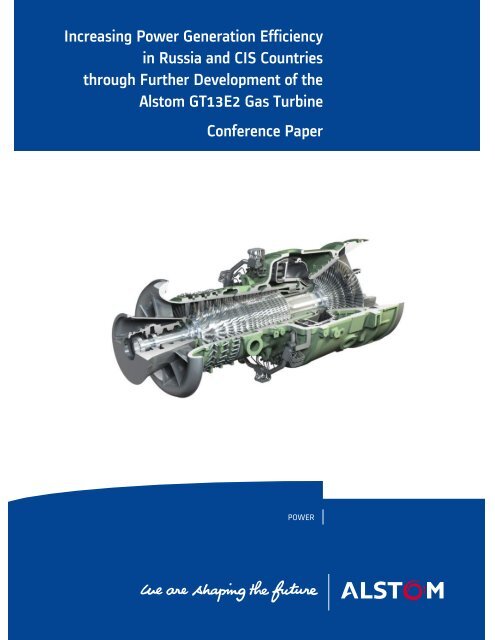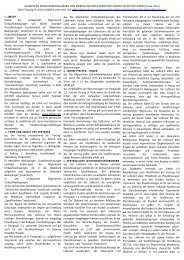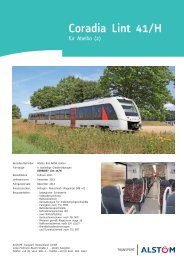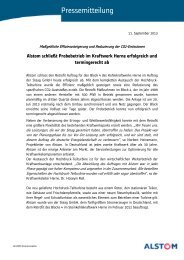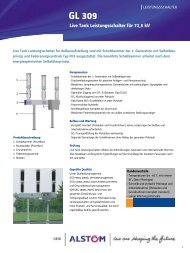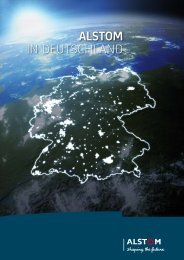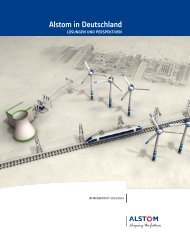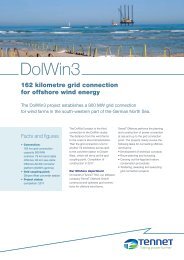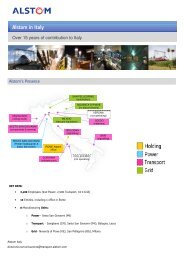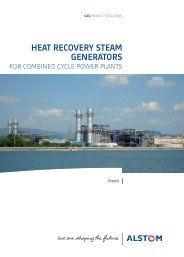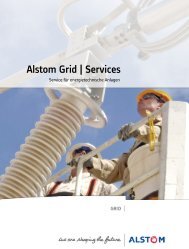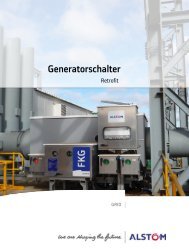Alstom GT13E2 gas turbine - Conference paper
Alstom GT13E2 gas turbine - Conference paper
Alstom GT13E2 gas turbine - Conference paper
Create successful ePaper yourself
Turn your PDF publications into a flip-book with our unique Google optimized e-Paper software.
Increasing Power Generation Efficiency<br />
in Russia and CIS Countries<br />
through Further Development of the<br />
<strong>Alstom</strong> <strong>GT13E2</strong> Gas Turbine<br />
<strong>Conference</strong> Paper<br />
POWER
Increasing Power Generation Efficiency in Russia and CIS Countries<br />
through Further Development of the <strong>GT13E2</strong> Gas Turbine<br />
Russia Power 2012 05-07 March 2012, Moscow, Russia<br />
© ALSTOM 2012. All rights reserved. Information contained in this document is indicative only. No representation or warranty is given or should be relied on that it is<br />
complete or correct or will apply to any particular project. This will depend on the technical and commercial circumstances. It is provided without liability and is subject<br />
to change without notice. Reproduction, use or disclosure to third parties, without express written authority, is strictly prohibited.
Paper presented at Russia Power in Moscow, Russia, 05-07 March 2012<br />
Increasing Power Generation Efficiency in Russia and<br />
CIS Countries through Further Development of the<br />
<strong>Alstom</strong> <strong>GT13E2</strong> Gas Turbine<br />
Bernard Tripod, Klaus Doebbeling, Christof Pfeiffer, Rudolf Heimerl<br />
<strong>Alstom</strong> Power<br />
Baden, Switzerland<br />
1 Introduction ...................................................................................................................4<br />
2 The <strong>GT13E2</strong> Development History..................................................................................7<br />
3 <strong>GT13E2</strong> – A Most Versatile Engine...............................................................................10<br />
4 <strong>GT13E2</strong> Upgrade ..........................................................................................................11<br />
5 <strong>GT13E2</strong> Benefits...........................................................................................................14<br />
6 Field Experience ...........................................................................................................19<br />
7 Service Offering............................................................................................................21<br />
8 Summary & Conclusions ...............................................................................................22<br />
9 Bibliography .................................................................................................................23
1 Introduction<br />
Changing market requirements<br />
Increasing Power Generation Efficiency in Russia and CIS Countries<br />
through Further Development of the <strong>GT13E2</strong> Gas Turbine<br />
Today’s power market generally requires solutions delivering the most economic electric power while<br />
minimizing the impact on the environment. This trend is likely to go on, putting increasing pressure on the<br />
development of new power generation products.<br />
The market requirements may vary strongly depending on the regions, driven by local power generation<br />
market structures and grid operation characteristics and, therefore, the priorities and the relative importance<br />
of these requirements may changes across the regions. However, the general trends show that large power<br />
generation plants need to be designed for the highest efficiency and operational flexibility to save fuel cost over<br />
a broad range of operating conditions, and matching a strongly changing power demand. This market<br />
segment is generally covered by combined cycle power plants based on large <strong>gas</strong> <strong>turbine</strong> units of the advanced<br />
technology offering the utmost performance levels.<br />
But in addition to this high-end market, another market segment exists requiring solutions based on smaller<br />
<strong>gas</strong> <strong>turbine</strong> units, sometimes in multi-unit configurations. For these projects, the main requirements for the<br />
<strong>gas</strong> <strong>turbine</strong> is the capability to meet the specific project requirements, to adapt plant configuration to the<br />
various applications to be served, and to offer the best customized solution with highest reliability, however<br />
without compromise on performance and environmental issues.<br />
For this segment, versatility is the key word. The <strong>GT13E2</strong> <strong>gas</strong> <strong>turbine</strong> has already demonstrated to be a most<br />
versatile engine, being used in connection with many different applications, and meeting a very broad range of<br />
environment and operation conditions. The <strong>GT13E2</strong> upgrade described in this <strong>paper</strong> further improves these<br />
capabilities.<br />
Russian <strong>gas</strong> power market development<br />
In the last two years the Russian power industry has gone through fundamental changes in regards to its<br />
power project developments. One goal of the Russian privatisation program was and still is to boost the<br />
installation of new and highly efficient power generation facilities, so that more <strong>gas</strong> could be sold on the<br />
international market.<br />
The recent trend has been to move away from highly standardised power generation towards optimised and<br />
tailored Combined Cycle Power Plants (CCPP). Together with the international procurement of main CCPP<br />
components such as the <strong>gas</strong> <strong>turbine</strong>(s), the heat recovery steam generator(s) (HRSG), the turbogenerator(s)<br />
and the steam <strong>turbine</strong>(s), this trend is just at its start and will steadily increase, so that the current project<br />
development process in general may have to be adjusted accordingly. Certified design institutes, for example,<br />
Russia Power 2012 05-07 March 2012, Moscow, Russia<br />
© ALSTOM 2012. All rights reserved. Information contained in this document is indicative only. No representation or warranty is given or should be relied on that it is<br />
complete or correct or will apply to any particular project. This will depend on the technical and commercial circumstances. It is provided without liability and is subject<br />
to change without notice. Reproduction, use or disclosure to third parties, without express written authority, is strictly prohibited.
Increasing Power Generation Efficiency in Russia and CIS Countries<br />
through Further Development of the <strong>GT13E2</strong> Gas Turbine<br />
will depend during the pre-feasibility stage more on the support and quality of input provided by equipment<br />
suppliers.<br />
Foreign Original Equipment Manufacturers (OEM’s) and EPC contractors have encountered difficulties when<br />
dealing with Russian codes and standards, as well as Russian work processes. In the course of these<br />
experiences many foreign OEM’s / EPC contractors are reluctant to offer turnkey CCPP’s. Hence, local Russian<br />
companies have to-date tended to build the combined cycle and/or cogeneration power plants and are still<br />
doing so.<br />
Depending on their experience, however, difficulties have occurred when the Russian EPC contractors have<br />
tried to integrate the main equipment components purchased abroad into a functional combined cycle power<br />
plant. The Russian EPC contractors have experienced challenges such as omitted/missing scope and final<br />
commissioning co-ordination issues, which in some cases, has made it extremely difficult to meet performance<br />
guarantees, project schedules and pricing budgets. This meanwhile has reached even federal authorities<br />
attention. One of the already initiated counter-measures for example is that the federal office<br />
GLAVGOSEXPERTIZA is putting increased attention to compliance of the complete development process (e.g.<br />
мдс -80-8.2000 “Guidelines”), in accordance with the Urban Planning Code, for the development of technical<br />
scope of tender documentation”), before a new CCPP permit is granted.<br />
With the different technical needs, EPC contractors are also faced with new commercial challenges. For<br />
example, balancing the risk profile in view of own capabilities versus scope of supply to be purchased and<br />
therefore level of risk outsourced becomes the important question for a competitive CCPP offer.<br />
For EPC contractors, with a strong in-house engineering division, it may look commercially more attractive to<br />
purchase individual equipment only and therefore take on more risk regarding possible omitted scope, overall<br />
performance guarantees, project time schedule etc. While for other EPC contractors it may be commercially<br />
more attractive to look for a greater risk-share with the main component supplier, e.g. in terms of Power<br />
Island (PI) overall performance guarantees, or commissioning schedule of the main PI components.<br />
With its unique power generation portfolio, <strong>Alstom</strong> has developed standard solutions ranging from the supply<br />
of main components to fully integrated power island solutions specifically engineered for the needs of the<br />
Russian market conditions. For all such solutions a scope description and clear division of work (DOW) will<br />
serve as a starting point with developers/owners and/or EPC contractors to tailor the project specific scope<br />
and DOW including the project risk sharing.<br />
With flexible product offerings, <strong>Alstom</strong> can tailor and customize its approach so that developers/owners and<br />
EPC contractors have more flexibility to optimise their in-house resources versus the technical and commercial<br />
requirements and finally the overall project risk profile.<br />
To-date, <strong>Alstom</strong> has supplied either directly or in consortium more than 170 turnkey Combined Cycle Power<br />
Plants worldwide, and continues to be one of the leading turnkey suppliers of CCPP solutions.
Russian market requirements<br />
Increasing Power Generation Efficiency in Russia and CIS Countries<br />
through Further Development of the <strong>GT13E2</strong> Gas Turbine<br />
The Russian & CIS power market has grown rapidly over the last decade. Russia is the fourth largest electricity<br />
producer in the world, behind only the US, China and Japan, and electricity consumption in the near- to midterm<br />
is expected to grow at about 2% per year. Demand for new capacity is driven both by economic growth<br />
and by the need to retire old plants. Nearly half of the installed capacity in Russia is over 30 years old, and a<br />
majority of these units are inefficient <strong>gas</strong>-fired steam plants. Based on new plant orders over the last five<br />
years, <strong>gas</strong> plants top nuclear, conventional steam, and hydro as Russia’s top choice for new capacity. This<br />
trend is expected to continue, with 60% of new capacity in the next ten years coming from <strong>gas</strong> <strong>turbine</strong> based<br />
power plants.<br />
A common market requirement is that the plant must be able to meet the steam needs of existing Combined<br />
Heat and Power (CHP) systems, which are prevalent throughout Russia. Repowering is another important<br />
market segment, where existing conventional steam plants are transformed into the steam cycle for a<br />
combined cycle plant. The choice of <strong>gas</strong> <strong>turbine</strong>s is sometimes simply based on which provides the best fit with<br />
the existing power plant. The most challenging requirement for <strong>gas</strong> plants in the Russian market, however, is<br />
the need to deal with extremely wide ranges of ambient temperatures. Operating temperatures typically are<br />
specified as a range from –40°C to +40°C.<br />
To cope with all the diverse conditions and requirements, a highly versatile type of engine is required. The<br />
<strong>Alstom</strong> <strong>GT13E2</strong> <strong>gas</strong> <strong>turbine</strong> is well adapted to the specific conditions of the Russian & CIS market and offers<br />
the highest performance in its class to produce economic and clean power. The <strong>GT13E2</strong> operation and<br />
experience records show that the <strong>GT13E2</strong> has proved to be the perfect fit for power generation projects, also<br />
including special applications like cogeneration projects for district heating, desalination or other industrial<br />
applications, or repowering opportunities.<br />
Only last year <strong>Alstom</strong> has been awarded 8 <strong>GT13E2</strong> units for projects in the region. Most of them will be used<br />
in combined cycle CHP projects for district heating application.<br />
Russia Power 2012 05-07 March 2012, Moscow, Russia<br />
© ALSTOM 2012. All rights reserved. Information contained in this document is indicative only. No representation or warranty is given or should be relied on that it is<br />
complete or correct or will apply to any particular project. This will depend on the technical and commercial circumstances. It is provided without liability and is subject<br />
to change without notice. Reproduction, use or disclosure to third parties, without express written authority, is strictly prohibited.
2 The <strong>GT13E2</strong> Development History<br />
Increasing Power Generation Efficiency in Russia and CIS Countries<br />
through Further Development of the <strong>GT13E2</strong> Gas Turbine<br />
In 2013, we will celebrate the 20th birthday of the <strong>GT13E2</strong> <strong>gas</strong> <strong>turbine</strong>. Since its first operation in 1993, the<br />
<strong>GT13E2</strong> <strong>gas</strong> <strong>turbine</strong>s have demonstrated significant user’s advantages of this technology platform.<br />
Unprecedented operational flexibility, robust design, high <strong>gas</strong> <strong>turbine</strong> efficiency, low emissions over a wide<br />
load range with world-class levels of reliability and availability are characteristics of these <strong>gas</strong> <strong>turbine</strong>s.<br />
The <strong>GT13E2</strong> is a medium sized <strong>gas</strong> <strong>turbine</strong> of the 200 MW class. It has a 21-stage compressor with a variable<br />
inlet guide vane, an annular combustion system with closed loop combustor cooling and a 5-stage <strong>turbine</strong>.<br />
Figure 2.1: <strong>GT13E2</strong> <strong>gas</strong> <strong>turbine</strong> thermal block<br />
The annular combustion system includes 72 EV (EnVironmental) burners. The EV burner is a dry low NOx<br />
burner with a long operating history and is used in the entire <strong>Alstom</strong> <strong>gas</strong> <strong>turbine</strong> portfolio, which allows a<br />
concentrated development and cross feed of improvements between the different <strong>gas</strong> <strong>turbine</strong> platforms. To<br />
cover the different power output requirements different numbers of burners are used in the different<br />
platforms.<br />
In 1993 the first <strong>GT13E2</strong> started operation. Major scope of the 2002 upgrade was a new <strong>turbine</strong> that pushed<br />
performance from 166 MW at 35.7% initially to 172 MW at 36.4% <strong>gas</strong> <strong>turbine</strong> efficiency. This upgrade also<br />
included TBC coating on the downstream part of the combustor, the so-called combustor zone 2, as well as<br />
the option to operate the engine at two different operation modes. These two different operation modes are<br />
using two different firing temperature levels such that for the lower temperature firing level the lifetime<br />
consumption is lower and hence operation intervals between inspections are longer. In parallel fuel switch
Increasing Power Generation Efficiency in Russia and CIS Countries<br />
through Further Development of the <strong>GT13E2</strong> Gas Turbine<br />
over from natural <strong>gas</strong> to fuel oil and vice versa was optimized such that fuel switch over can reliably be done<br />
also at full load.<br />
PERFORMANCE<br />
PERFORMANCE<br />
PERFORMANCE<br />
PERFORMANCE<br />
FLEXIBILITY<br />
FLEXIBILITY<br />
FLEXIBILITY<br />
• <strong>Alstom</strong> Standard EV<br />
Burner<br />
• M-Turbine upgrade<br />
implemented<br />
• Performance<br />
Gross: 172 MW, 36.4%<br />
2002<br />
• Flexible lifetime concept<br />
(performance optimized<br />
and maintenance cost<br />
optimized mode)<br />
• High fuel flexibility<br />
2005<br />
Figure 2.2: <strong>GT13E2</strong> performance and flexibility evolution<br />
• Compressor upflow<br />
• Turbine Blade 5 and<br />
Combustor Improvements<br />
• Performance<br />
Gross: 178 MW, 36.7%<br />
• Extension of capability<br />
for low and high ambient<br />
temperature<br />
• Incremental<br />
improvements in Turbine<br />
and Combustor<br />
• Auxiliary system<br />
improvements<br />
2006, 2009, 2010<br />
180, 182, 184 MW<br />
36.9, 37.4, 37.8 %<br />
Basis: ISO<br />
• High fogging power<br />
augmentation<br />
• Fast start<br />
2012<br />
In the 2005 upgrade the compressor stages 1-5 have been re-staggered to increase the mass flow by<br />
approximately 4%. The profile of the last <strong>turbine</strong> blade was optimized to match the increased mass flow. In the<br />
front part of the combustor, the so-called combustor zone 1 liner segments, thermal barrier coating (TBC) was<br />
applied and the film-cooling pattern was adapted. As a result improved flame stability and lower NOx<br />
emissions over a wider ambient temperature range were achieved.<br />
Continuous improvements and product care especially through the use of optimized coatings, through leakage<br />
reductions and reduction of auxiliary power consumption as result of feedback obtained from of over hundred<br />
operating <strong>GT13E2</strong> engines in 2005 allowed stepwise performance increase to 184 MW and 37.8% gross<br />
efficiency. Upgrades of the control software and hardware resulted in faster start and higher load gradients.<br />
Implementation of power augmentation options like air inlet cooling, high fogging and water injection resulted<br />
in the possibility to keep the power output almost constant from 15°c ambient temperature up to 45°c.<br />
Today, the <strong>GT13E2</strong> has been sold more than 150 times worldwide and the fleet has accumulated more than<br />
7.5 million operating hours and over 54’000 starts. 21 engines have accumulated more than 100’000 fired<br />
hours with the fleet leader having achieved over 128’000 hours. 10 engines had more than 1’000 start/stop<br />
cycles.<br />
Russia Power 2012 05-07 March 2012, Moscow, Russia<br />
© ALSTOM 2012. All rights reserved. Information contained in this document is indicative only. No representation or warranty is given or should be relied on that it is<br />
complete or correct or will apply to any particular project. This will depend on the technical and commercial circumstances. It is provided without liability and is subject<br />
to change without notice. Reproduction, use or disclosure to third parties, without express written authority, is strictly prohibited.
Figure 2.3: <strong>GT13E2</strong> global references<br />
Increasing Power Generation Efficiency in Russia and CIS Countries<br />
through Further Development of the <strong>GT13E2</strong> Gas Turbine<br />
The <strong>GT13E2</strong> has demonstrated superior reliability. Figure 2.3 shows the latest reliability figures over the period<br />
from 3rd quarter 2010 to 3rd quarter 2011 from the ORAP report of the independent SPS/ORAP report. The<br />
reliability figures of the <strong>GT13E2</strong> are clearly and consistently above that of the average of the industry.<br />
Figure 2.3: <strong>GT13E2</strong> reliability<br />
Reliability ( % )<br />
WESTERN EUROPE<br />
SC – 5 UNITS<br />
CC – 21 UNITS<br />
NORTH AFRICA<br />
SC – 12 UNITS<br />
CC – 2 UNITS<br />
WESTERN AFRICA<br />
SC – 6 UNITS<br />
CC – 3 UNITS<br />
100%<br />
98%<br />
96%<br />
94%<br />
92%<br />
90%<br />
LATIN AMERICA<br />
CC – 2 UNITS<br />
GULF<br />
SC – 20 UNITS<br />
CC – 13 UNITS<br />
RUSSIA & CIS<br />
SC – 3 UNITS<br />
CC – 9 UNITS<br />
INDIA<br />
SC – 1 UNITS<br />
OCEANIA<br />
SC – 12 UNITS<br />
CC – 4 UNITS<br />
MIDDLE EAST<br />
SC – 12 UNITS<br />
CHINA<br />
SC – 1 UNITS<br />
<strong>GT13E2</strong> ORAP RAM Values <strong>GT13E2</strong><br />
(12 Month Rolling Averages) E Class Technology<br />
All Values are for Simple Cycle Plant (GT, Generator, and Station Equipment)<br />
ASIA<br />
SC – 27 UNITS<br />
CC – 4 UNITS<br />
3Q10 4Q10 1Q11 2Q11 3Q11
3 <strong>GT13E2</strong> – A most Versatile Engine<br />
Increasing Power Generation Efficiency in Russia and CIS Countries<br />
through Further Development of the <strong>GT13E2</strong> Gas Turbine<br />
Over the years, the <strong>GT13E2</strong> has proved its unsurpassed versatility in countless projects around the world,<br />
being used with benefits in all kinds of applications or plant configurations, and under a wide range of<br />
operational conditions.<br />
- Used under very different ambient conditions, from cold to hot places, from dry sandy sites to wet<br />
seashores or polluted industrial areas<br />
- Used extensively for both simple cycle as well as combined cycle plants<br />
- Used in connection with very demanding industrial application, like aluminium smelters etc., often<br />
powering small island electrical grids, without connection or support from large utility networks<br />
- One third of the installed fleet used for simple cycle or combined cycle cogeneration applications (CHP<br />
plants), with heat supplied to district heating systems, desalination plants or industrial processes<br />
- Several projects were started as simple cycle then converted into full combined cycle plants through steam<br />
tail add-on, while some <strong>GT13E2</strong> units have been used in repowering applications, for the conversion of<br />
existing steam power plants into combined cycle plants<br />
- Many combined cycle plants have been fitted with bypass stack, some of them for phased installation and<br />
operation first of the <strong>gas</strong> and later of the steam <strong>turbine</strong>(s) – i.e. steam tail add-on as above mentioned<br />
- Many of them, especially in very hot climatic regions, have been fitted with air inlet cooling systems<br />
- Running on very different types of fuel, with a broad range of <strong>gas</strong> or liquid fuel compositions, and also<br />
varying compositions during operation, etc., in <strong>gas</strong> only, dual fuel, or oil only configurations<br />
Figure 3.1 shows the example of Alba combined cycle plant, in Bahrain, based on three blocks KA13D-3 (3on-1<br />
configuration) and two blocks KA13E2-2 (2-on-1 configuration) for a total of 1530 MW, mostly operated<br />
in island configuration<br />
Figure 3.1: Alba – One of the largest aluminium smelter plants in the world<br />
Russia Power 2012 05-07 March 2012, Moscow, Russia<br />
© ALSTOM 2012. All rights reserved. Information contained in this document is indicative only. No representation or warranty is given or should be relied on that it is<br />
complete or correct or will apply to any particular project. This will depend on the technical and commercial circumstances. It is provided without liability and is subject<br />
to change without notice. Reproduction, use or disclosure to third parties, without express written authority, is strictly prohibited.
4 <strong>GT13E2</strong> Upgrade<br />
Development focus<br />
Increasing Power Generation Efficiency in Russia and CIS Countries<br />
through Further Development of the <strong>GT13E2</strong> Gas Turbine<br />
In the recent years even more challenging requirements for flexibility and environmental friendliness have<br />
emerged. New governmental regulations on emission reduction over a broad load range and for largely<br />
varying natural <strong>gas</strong> composition have or will be put in force. Varying energy demand during day/night and<br />
summer/ winter as well as the increasing number of wind and solar power generation units further make<br />
operational flexibility a key requirement. Already today <strong>Alstom</strong> <strong>gas</strong> <strong>turbine</strong>s meet most of these future<br />
conditions and requirements.<br />
In order to further enhance performance and operational flexibility of the <strong>GT13E2</strong> an upgrade has been<br />
defined, based on<br />
- integration of a proven compressor with higher mass flow and better turndown capability<br />
- upgraded combustion system<br />
Figure 4.1: <strong>GT13E2</strong> development focus<br />
Compressor<br />
Compressor<br />
LP compressor of the GT26 <strong>gas</strong> <strong>turbine</strong><br />
Combustor<br />
Advanced EnVironmental (AEV) burners<br />
To increase the power output and the turndown capability of the <strong>GT13E2</strong> the first 16 stages of the proven<br />
compressor used in the GT26 have been integrated into the <strong>GT13E2</strong> engine. Three variable guide vanes allow<br />
a wider range of turn down at higher compressor efficiency as compared to the previous compressor with<br />
single variable guide vane row. The mass flow of the engine is increased by approximately 10%. The<br />
compressor blades and vanes as well as the compressor housing and the compressor section of the rotor have
Increasing Power Generation Efficiency in Russia and CIS Countries<br />
through Further Development of the <strong>GT13E2</strong> Gas Turbine<br />
been taken over from the GT26 with minor adaptations to the <strong>GT13E2</strong>. The air intake system and the rotor<br />
bearing on the compressor side are also adapted from the GT26 design so that the previously used<br />
intermediate shaft to the generator is no longer required resulting in a shorter arrangement. Compressor<br />
bleeds have been found to match well the <strong>turbine</strong> cooling system requirements. Blow off during start-up of the<br />
engine is injected into the exhaust system eliminating the previously used blow off silencers.<br />
Figure 4.2– <strong>GT13E2</strong> Gas Turbine compressor based on the GT26 compressor<br />
The compressor design builds on a fleet experience of more than sixty GT26 engines. It includes the air inlet<br />
cooling and power augmentation systems successfully in operation on many GT26 <strong>turbine</strong>s.<br />
Combustor<br />
GT26 Gas Turbine<br />
LP Compressor<br />
The combustion system has been upgraded to further enhance the emission behaviour and the operational<br />
flexibility of the <strong>GT13E2</strong> by implementing the Advanced EnVironmental (AEV) burner. The AEV burner is based<br />
on the well proven standard <strong>Alstom</strong> <strong>gas</strong> <strong>turbine</strong> EV burner technology as an evolutionary approach for both<br />
<strong>gas</strong> and fuel oil operation.<br />
The design features of the AEV burner are shown in figure 4.3. Main difference between the AEV and the EV<br />
burner is the dedicated mixing section in the burner body downstream of the swirler. The design of the fourslot<br />
swirler is aerodynamically optimized with a higher throughput of combustion air as compared to the<br />
existing <strong>GT13E2</strong> EV design. As a result the number of burners is reduced, from 72 EV burners to 48 AEV<br />
burners.<br />
Russia Power 2012 05-07 March 2012, Moscow, Russia<br />
© ALSTOM 2012. All rights reserved. Information contained in this document is indicative only. No representation or warranty is given or should be relied on that it is<br />
complete or correct or will apply to any particular project. This will depend on the technical and commercial circumstances. It is provided without liability and is subject<br />
to change without notice. Reproduction, use or disclosure to third parties, without express written authority, is strictly prohibited.
Figure 4.3: AEV burner design features<br />
Increasing Power Generation Efficiency in Russia and CIS Countries<br />
through Further Development of the <strong>GT13E2</strong> Gas Turbine<br />
The integration of the mixing section downstream of the swirler in the burner body ensures an almost perfectly<br />
homogeneous mixture of fuel and combustion air, resulting in very low NOx emissions on both <strong>gas</strong> and oil<br />
operation.<br />
For oil operation, the mixing section provides sufficient residence time for atomization, pre-vaporization and<br />
mixing of the liquid fuel. As a consequence less than half of the water is consumed for control of the NOx<br />
emissions compared to the EV burner.<br />
An important feature of the AEV burner is the front stage <strong>gas</strong> injection through multiple nozzles, which are<br />
arranged circumferentially around the burner exit plane. With this solution the stability of the flame generated<br />
by the internal fuel stage is increased against flame extinction and pulsations. Hence the AEV burner system<br />
can be permanently operated over the entire load range with low NOx emissions.<br />
A robust combustion is obtained by the presence of the mixing section, the flame front being insensitive to<br />
variations of air temperature and humidity as well as natural <strong>gas</strong> composition and <strong>gas</strong> temperature. Therefore,<br />
the <strong>GT13E2</strong> upgrade with AEV burner sees its fuel and operational flexibility further enhanced. As a direct<br />
consequence of the AEV operation concept, the fuel system is simplified.<br />
Other improvement areas<br />
Further to the major changes on the compressor and combustor as described above, the <strong>GT13E2</strong> upgrade can<br />
benefit from of a number of small design improvements and refinements:<br />
- The same <strong>turbine</strong> from the 2005 rating is used for this upgrade, as the large cross sectional flow of the last<br />
<strong>turbine</strong> stage allows accommodating the higher mass flow from the compressor. Because of the change of
Increasing Power Generation Efficiency in Russia and CIS Countries<br />
through Further Development of the <strong>GT13E2</strong> Gas Turbine<br />
the firing temperature by less than 20°C, the first blade row received full thermal barrier coating (TBC)<br />
coverage for improved lifetime<br />
- A larger type of TOPAIR air-cooled generator is used to accommodate the higher power output of the <strong>gas</strong><br />
<strong>turbine</strong>, with margins for power augmentation. It can be optimized to allowing for 3 different ratings in<br />
the range of 255 to 280 MVA, hence enabling adjustment to plant specific requirements at maximized<br />
generator efficiency<br />
- The arrangement of the <strong>gas</strong> <strong>turbine</strong> auxiliary systems has been optimised with increased modularization<br />
through the use of pre-engineered and factory tested functional modules<br />
- Further, to reduce and simplify maintenance several small improvements have been brought to the <strong>gas</strong><br />
<strong>turbine</strong> to facilitate tasks like alignment or lifting of components<br />
5 <strong>GT13E2</strong> Benefits<br />
Performance<br />
The <strong>GT13E2</strong> upgrade brings performance improvements in many regards:<br />
- Engine nominal output and efficiency<br />
- Combined cycle plant output<br />
- Simple cycle and combined cycle part load efficiency<br />
- Engine performance at high ambient conditions<br />
Nominal performance<br />
Since its first operation in 1993, the <strong>GT13E2</strong> could claim the best performance in it class. With the new<br />
upgrade, it becomes even better: 202.7 MW / 38% gross engine performance at generator terminals, i.e. a 10%<br />
power output increase, and +0.2%-pt efficiency improvement.<br />
The combined cycle plant performance is also boosted, gaining 48 MW in a 2-on-1 plant configuration, with<br />
net plant efficiency maintained at high level.<br />
<strong>GT13E2</strong> Engine Performance<br />
Gross electrical output MW 202.7<br />
Gross electrical efficiency (LHV) % 38.0 - ISO Conditions<br />
Gross heat rate (LHV) kJ/kWh 9476 - Natural <strong>gas</strong><br />
Btu/kWh 8982 - Gross performance at generator terminals<br />
no inlet/outlet losses<br />
KA13E2-2 Combined Cycle Power Plant Performance<br />
Net plant electrical output MW 565 - ISO Conditions<br />
Net plant electrical efficiency (LHV) % 53.8 - Natural <strong>gas</strong><br />
Net plant heat rate (LHV) kJ/kWh 6696 - Double pressure non reheat CCPP configuration<br />
Btu/kWh 6347 - Net plant performance<br />
at main step-up transformer HV terminals<br />
Russia Power 2012 05-07 March 2012, Moscow, Russia<br />
© ALSTOM 2012. All rights reserved. Information contained in this document is indicative only. No representation or warranty is given or should be relied on that it is<br />
complete or correct or will apply to any particular project. This will depend on the technical and commercial circumstances. It is provided without liability and is subject<br />
to change without notice. Reproduction, use or disclosure to third parties, without express written authority, is strictly prohibited.
Part load behaviour<br />
Increasing Power Generation Efficiency in Russia and CIS Countries<br />
through Further Development of the <strong>GT13E2</strong> Gas Turbine<br />
The use of the GT26 low-pressure compressor with 3 variable guide vanes (VGV’s) instead of just one results<br />
in a better part-load efficiency characteristics for both simple cycle and combined cycle applications. The<br />
improved part-load performance permits to generate significant fuel savings. As an example, the <strong>GT13E2</strong><br />
upgrade operating on <strong>gas</strong> at 75% GT load will consume about 2% less fuel than with the previous rating,<br />
therefore positively contributing to any project economic results.<br />
Plant<br />
Relative<br />
Efficiency<br />
100%<br />
Figure 5.1: KA13E2-2 part load behaviour<br />
Figure 5.1 shows the gain in efficiency of a KA13E2-2 combined cycle 2-on-1 plant configuration. The part<br />
load behaviour of the upgrade permits to save more than 1% fuel when operating at 75% GT load, and as much<br />
as to 4-5% at 50% GT load.<br />
Performance at hot ambient conditions<br />
100% 75%<br />
Gas Turbine Load<br />
50%<br />
While the <strong>GT13E2</strong> efficiency at low ambient conditions remains significantly better than any comparable<br />
machine, the characteristics of the 2012 upgrade permits to offer better efficiency at high ambient conditions.<br />
This is especially valuable in typical hot climate countries where hot summer conditions also mean the highest<br />
power demand, because of air conditioning loads. As an example, at 45°C ambient temperature, the new<br />
upgrade will still have 16 MW more power than the previous rating in simple cycle, with an efficiency benefit<br />
of more than 0.8%-pt.<br />
In addition, the range of air inlet cooling options (evaporative cooling, fogging, high fogging) permit to keep<br />
the power output characteristics flat over a wide range of ambient temperature.<br />
> 1%<br />
<strong>GT13E2</strong><br />
Upgrade<br />
<strong>GT13E2</strong><br />
before upgrade<br />
4-5%
Emissions<br />
Increasing Power Generation Efficiency in Russia and CIS Countries<br />
through Further Development of the <strong>GT13E2</strong> Gas Turbine<br />
The introduction of the AEV burners permits to significantly improve the environmental performance of the<br />
machine: Running on natural <strong>gas</strong>, the full load NOx emissions are reduced from 25 vppm 1 down to 15 vppm.<br />
The turndown is also improved, since the <strong>GT13E2</strong> upgrade is able to operate down to 70% load meeting the<br />
low 15 vppm NOx emissions, and further down to 50% GT load not exceeding the 25 vppm NOx World Bank<br />
standards.<br />
The AEV burner brings also important benefits when running on #2 oil, as the <strong>GT13E2</strong> is now able to run with<br />
25 vppm NOx emission in the 100% down to 70% GT load range. The 42 vppm (typical European standard<br />
requirement) can even be met down to 50% load. NOx control on oil operation is by water injection, which<br />
could be strongly reduced. The amount of water required to meet 42 vppm NOx is about 60% lower.<br />
The AEV burner environmental performance is almost immune to variations of the air conditions at GT inlet,<br />
meaning that the <strong>gas</strong> <strong>turbine</strong> can deliver clean power at low ambient conditions as well as in hot climate, even<br />
with air inlet cooling systems in operation.<br />
Finally, it must be mentioned that the CO2 emissions are reduced as a direct consequence of the better<br />
efficiency of the <strong>gas</strong> <strong>turbine</strong> - both at full load and at part loads.<br />
Fuel flexibility<br />
The superior fuel flexibility demonstrated already with the <strong>GT13E2</strong> fleet in operation is fully achieved with the<br />
AEV-equipped <strong>GT13E2</strong> upgrade as well. The experience range with respect to the Wobbe Index extends from<br />
31 MJ/m 3 to 49 MJ/m 3 , i.e. a ±23% range. In terms of C2+ content, values of up to 25% in volume are<br />
demonstrated without negative impact on performance, reliability and compliance with emission<br />
requirements. The robustness of the combustion system and the associated control system allows these<br />
engines to operate under these varying conditions without the need for re-adjustment of settings or changes<br />
of hardware. The <strong>GT13E2</strong> is not only capable to run on a wide range of fuel <strong>gas</strong> compositions, it can also allow<br />
fast and wide variations in the fuel <strong>gas</strong> quality.<br />
On-line fuel switch-over<br />
In case of decreasing fuel <strong>gas</strong> supply pressure, fast fuel switch over from <strong>gas</strong> to oil operation ensures<br />
uninterrupted stable power supply. Such fuel switch over can be executed while the machine remains at full<br />
load. Switch over at constant load is also possible at part loads down to 40% GT load.<br />
1 Note: vppm to be read as vppm, dry (corrected to 15% O2)<br />
Russia Power 2012 05-07 March 2012, Moscow, Russia<br />
© ALSTOM 2012. All rights reserved. Information contained in this document is indicative only. No representation or warranty is given or should be relied on that it is<br />
complete or correct or will apply to any particular project. This will depend on the technical and commercial circumstances. It is provided without liability and is subject<br />
to change without notice. Reproduction, use or disclosure to third parties, without express written authority, is strictly prohibited.
Start-up<br />
Increasing Power Generation Efficiency in Russia and CIS Countries<br />
through Further Development of the <strong>GT13E2</strong> Gas Turbine<br />
The permanent operation of the AEV burner with two fuel stages allows a fast adjustment of the combustion<br />
resulting in an improved behaviour for transient operation conditions such as fast loading, frequency response<br />
or load rejection.<br />
The standard start-up time is 25 minutes from start initiation (push button) to more than 200 MW at the<br />
generator terminals (ISO conditions). With the upgrade <strong>GT13E2</strong> the start-up time can be even reduced to 15<br />
minutes (figure 5.2). This is done through increased start-up power during the rotor acceleration phase<br />
combined with a smart ramp-up load control, allowing for higher loading gradients within a selected load<br />
range. Warm and hot start-up times of 15 minutes are possible without additional lifetime counting on the<br />
<strong>gas</strong> <strong>turbine</strong> as compared to the 25 min start. By making use of an optional roller shutter in the air intake, the<br />
status “warm engine” can be extended up-to 60 hours from shut-down.<br />
Figure 5.2: <strong>GT13E2</strong> start-up<br />
Parameters [%]<br />
100<br />
(Base Load)<br />
80<br />
60<br />
40<br />
20<br />
Acceleration<br />
Speed Speed Speed<br />
Synchronization<br />
Loading<br />
15 15 15 min. min. min. Start Start Start<br />
Over 200 MW in only 15 minutes<br />
Operation at low ambient conditions<br />
25 25 25 min. min. min. Start Start Start<br />
0<br />
0 5 15 20 25<br />
Starting times including engine preparation time<br />
Time [min.]<br />
Reliable operation at very low ambient condition is no exceptional feat for the <strong>GT13E2</strong> upgrade, which became<br />
even more robust, and saw its capability at very low ambient conditions improved:<br />
- Emission compliant operation without air pre-heater down to -10°C ambient temperature down to 50%<br />
relative GT load; as a consequence, the pre-heater size can be reduced for lower ambient temperatures as<br />
only -10°C must be achieved at GT inlet<br />
- Cold starts are allowed down to –30°C ambient temperature without air pre-heater in operation<br />
- With pre-heater the <strong>gas</strong> <strong>turbine</strong> is operational down to -50°C
Cogeneration operation<br />
Increasing Power Generation Efficiency in Russia and CIS Countries<br />
through Further Development of the <strong>GT13E2</strong> Gas Turbine<br />
Cogeneration (CHP – Combined Heat and Power) operation very often requires that the heat supply can be<br />
ensured independently of the <strong>gas</strong> <strong>turbine</strong> power output. Also, the steam parameters must normally be kept<br />
constant so that the operation of the process using the steam is not disturbed.<br />
The use of three rows of variable guide vanes not only offers superior part load performance, but it also<br />
ensures that the <strong>gas</strong> <strong>turbine</strong> exhaust temperature remains high over a wide range of GT operating loads. This<br />
generally represents a key benefit for CHP plants, as it permits to keep the steam parameters constant<br />
independently of the <strong>gas</strong> <strong>turbine</strong> power output, over a wide load range.<br />
Maintenance improvements<br />
A number of small refinements and improvements have been made so as to increase the ease of maintenance.<br />
Measures have been taken to facilitate maintenance tasks such as alignments and lifting of components. Preengineered<br />
functional modules have been introduced for the auxiliary systems, and the fuel system has been<br />
simplified. Together with the reduction in the number of parts (e.g. from 72 EV burners down to 48 AEV<br />
burners), the duration of the maintenance work and effort is reduced.<br />
Further benefits of the <strong>GT13E2</strong><br />
In addition to the specific benefits of the <strong>GT13E2</strong> above described, this machine also features many advanced<br />
characteristics inherited from the previous <strong>GT13E2</strong> rating, such as:<br />
Flexible operation modes<br />
The <strong>GT13E2</strong> can be operated either in the so-called “Performance Optimized” (PO) operation mode or in the<br />
“Maintenance Cost Optimized” (MCO) operation mode. For a slight decrease in the performance (
Increasing Power Generation Efficiency in Russia and CIS Countries<br />
through Further Development of the <strong>GT13E2</strong> Gas Turbine<br />
<strong>GT13E2</strong> based combined cycle power plants can easily be fitted with large supplementary firing, allowing high<br />
power supply flexibility, and increased power vs. heat production flexibility for CHP plants.<br />
Figure 5.3: SC13E2 / KA13E2 high power output flexibility<br />
Figure 5.3 shows the wide power output range at ISO conditions of the simple cycle and 1-on-1 combined<br />
cycle configurations. The emission-compliant range extends for the combined cycle case from 50% (min.<br />
environmental turndown) to + 118% (full load combined cycle power output, with HF and SF). This range<br />
increases at high ambient conditions, as the air inlet cooling will become more effective.<br />
6 Field Experience<br />
Compressor<br />
CC + HF + SF<br />
CC<br />
SC + HF<br />
SC<br />
Low Emissions SC<br />
Low Emissions CC<br />
PA CC<br />
• SC<br />
• CC<br />
Simple Cycle<br />
Combined Cycle<br />
50 100 150 200<br />
PA SC<br />
250 300 350 MWel<br />
• HF High Fogging<br />
• SF<br />
• PA<br />
Supplementary Firing<br />
Power Augmentation<br />
SC CC<br />
min. Environmental<br />
SC CC<br />
Basis: One GT unit / ISO conditions<br />
Turndown<br />
The first 16 stages of the well-proven GT26 compressor are now used for the <strong>GT13E2</strong> upgrade development.<br />
Extensive compressor testing, including surge test have been performed in 2002 at the <strong>Alstom</strong> test GT26 test<br />
power plant in Birr, Switzerland. This compressor design is now installed and running in more than sixty GT26<br />
<strong>gas</strong> <strong>turbine</strong>s where it could demonstrate its reliability. Today, the cumulated experience amounts to over 1.2<br />
million fired hours, with the fleet leader having achieved more than 60’000 operating hours.
Combustor<br />
Increasing Power Generation Efficiency in Russia and CIS Countries<br />
through Further Development of the <strong>GT13E2</strong> Gas Turbine<br />
After full-scale tests in the <strong>Alstom</strong> GT8C2 Test Power Plant, the AEV combustor upgrade package has been<br />
installed in three <strong>GT13E2</strong> customer units, the first already in 2006, and was very successfully validated,<br />
demonstrating the improved operational flexibility and the reduced emissions. At different ambient conditions<br />
stable low NOx emissions well below the emission permit levels on <strong>gas</strong> fuel and on fuel oil could be<br />
demonstrated without any need for re-adjustment of the engine or tuning of the combustor system.<br />
Figure 6.1 – <strong>Alstom</strong> GT8C2 Test plant Figure 6.2 – Vattenfall’ Berlin Mitte Power Plant<br />
RWE<br />
Ludwigshaven<br />
<strong>GT13E2</strong><br />
Vattenfall<br />
Berlin Mitte<br />
<strong>GT13E2</strong><br />
Nuon<br />
Diemen<br />
<strong>GT13E2</strong><br />
2006 2007 2008 2009<br />
1 2 3 4 5 6 7 8 9 10 11 12 1 2 3 4 5 6 7 8 9 10 11 12 1 2 3 4 5 6 7 8 9 10 11 12 1 2 3 4 5 6 7 8 9 10 11 12 1 2 3 4 5 6 7 8 9 10 11 12<br />
1st Gas<br />
AEV upgrade<br />
Dual fuel AEV upgrade<br />
Figure 6.3 – Plants operating with AEV Retrofit Upgrade<br />
To date the total operation experience with the AEV burners on <strong>GT13E2</strong> <strong>gas</strong> <strong>turbine</strong>s has exceeded 80’000<br />
operation hours. The <strong>GT13E2</strong> <strong>gas</strong> <strong>turbine</strong> with dual fuel operation is operating reliably for more than two years<br />
and has accumulated more than 16’500 OH with the AEV dual fuel burner. The AEV Burner is now offered<br />
both as retrofit to the existing fleet, as well as standard component for the new <strong>GT13E2</strong> engines.<br />
Russia Power 2012 05-07 March 2012, Moscow, Russia<br />
© ALSTOM 2012. All rights reserved. Information contained in this document is indicative only. No representation or warranty is given or should be relied on that it is<br />
complete or correct or will apply to any particular project. This will depend on the technical and commercial circumstances. It is provided without liability and is subject<br />
to change without notice. Reproduction, use or disclosure to third parties, without express written authority, is strictly prohibited.<br />
2010<br />
2nd 2 Gas<br />
AEV upgrade<br />
nd 2 Gas<br />
AEV upgrade<br />
nd Gas<br />
AEV upgrade
7 Service Offering<br />
Increasing Power Generation Efficiency in Russia and CIS Countries<br />
through Further Development of the <strong>GT13E2</strong> Gas Turbine<br />
<strong>Alstom</strong> has more than 100 years of experience in engineering, procurement and construction (EPC) of new<br />
power plants, and our engineers are also experts in retrofitting, modernizing and servicing existing plants.<br />
With operations in over 70 countries, <strong>Alstom</strong> is close to their customers all over the world, ensuring rapid<br />
response and service at all times. Utilities, independent power producers and merchant power generators are<br />
all looking to maximize the returns on their investments, by optimizing operations and managing risks. As a<br />
leading Gas Turbine Original Equipment Manufacturer (OEM) and turnkey power plant provider, <strong>Alstom</strong><br />
possesses the unique extensive technical expertise and equipment know-how to ensure that their client’s<br />
equipment remains competitive throughout the lifecycle of the product.<br />
The OEM commitment to continuous development efforts on all major equipment products, such as<br />
performance upgrade packages using the latest state-of-the-art <strong>gas</strong> <strong>turbine</strong> and combustion technology help<br />
the plant owners to produce more power, while using less fuel and reducing emissions. Extending operation<br />
intervals between scheduled outages enables more production and lower maintenance costs. Innovative<br />
reconditioning of hot <strong>gas</strong> path parts uses the latest proven technology to keep engines operational, with a<br />
quality assurance that can only be provided by the OEM supplier.<br />
<strong>Alstom</strong>’s flexible and customized expert services cover solutions at all stages of the plant lifecycle, including:<br />
- New and improved parts, reconditioning of parts<br />
- Advice and operational support<br />
- Field service<br />
- Performance improvements on components and full plant<br />
- Plant integration capabilities<br />
- Service contracts, also on other OEM <strong>gas</strong> <strong>turbine</strong> equipment<br />
<strong>Alstom</strong>’s service contracts for GT and CCPP are tailored to meet the needs of all operational, maintenance and<br />
support requirements. From Long Term Agreements (LTA) covering the supply of parts and provision of<br />
services, to Operation and Maintenance (O&M) contracts, which allow plant owners to devise completely new<br />
management strategies by outsourcing risks and responsibilities, <strong>Alstom</strong>’s O&M contracts allow clients to take<br />
advantage of performance and availability guarantees through tailored agreements that perfectly suit the<br />
required service and equipment scope.<br />
With existing commercial power plants in Armenia (Hrazdan, Yerevan), Belarus (Minsk) and Russia<br />
(Moscow), and a rapidly expanding <strong>GT13E2</strong> fleet in Russia, <strong>Alstom</strong>’s commitment to provision of local services<br />
in Russia and CIS countries is in direct focus. The availability of local services from Russian-speaking teams is<br />
considered to be of vital importance to provide the necessary OEM support for the growing fleet.
8 Summary & Conclusions<br />
Increasing Power Generation Efficiency in Russia and CIS Countries<br />
through Further Development of the <strong>GT13E2</strong> Gas Turbine<br />
The very successful <strong>Alstom</strong> <strong>GT13E2</strong> <strong>gas</strong> <strong>turbine</strong> with best-in-class performance, high reliability, high<br />
operational flexibility and unique versatility to adapt to a broad range of applications and operation conditions<br />
has been further improved. The <strong>GT13E2</strong> upgrade significantly extends the already well-recognized benefits of<br />
the machine:<br />
- Increased simple cycle performance – more than 200 MW at 38% gross efficiency (+10% output / + 0.2%-pt<br />
efficiency)<br />
- Improved net combined cycle plant performance - 565 MW / 53.8% (+9% output / + 0.2%-pt efficiency) for<br />
a 2-on-1 power plant configuration<br />
- Improved part load efficiency<br />
- Improved high ambient temperature performance / improved low ambient temperature capability<br />
- Reduced emissions levels, improved environmental turndown and environment compliant power<br />
augmentation solutions<br />
- Fast GT start with >200 MW available in 15 minutes, without additional lifetime counting vs. 25 min.<br />
start, for warm and hot starts<br />
- High fuel composition flexibility without hardware changes<br />
- On-line fuel switch-over at constant load, for <strong>gas</strong> <strong>turbine</strong> loads between 40% and 100%<br />
- Switchable (on-line) operation modes to adjust the <strong>gas</strong> <strong>turbine</strong> performance according to market<br />
requirements and, therefore, optimize the plant economics<br />
- Improved capability for cogeneration operation, due to the improved <strong>gas</strong> <strong>turbine</strong> exhaust <strong>gas</strong> temperature<br />
characteristics<br />
- Full range of power augmentation options with guaranteed performance and no impact on intervals<br />
between inspections<br />
- Reduced maintenance requirements<br />
The development of the 2012 upgrade was entirely based on an evolutionary approach, making full use of the<br />
well-proven <strong>GT13E2</strong> platform, together fully validated components:<br />
- The first 16 stages of the GT26 compressor design used for this upgrade is operating in more than sixty<br />
GT26 units, totalling more than 1’200’000 running hours experience.<br />
- The Advanced EV burner (AEV burner), a further development of the standard EV burner used in all <strong>Alstom</strong><br />
<strong>gas</strong> <strong>turbine</strong>s, is operating commercially in three customer engines, with more than 80’000 fired hours<br />
experience.<br />
…The Best becomes Better!<br />
Russia Power 2012 05-07 March 2012, Moscow, Russia<br />
© ALSTOM 2012. All rights reserved. Information contained in this document is indicative only. No representation or warranty is given or should be relied on that it is<br />
complete or correct or will apply to any particular project. This will depend on the technical and commercial circumstances. It is provided without liability and is subject<br />
to change without notice. Reproduction, use or disclosure to third parties, without express written authority, is strictly prohibited.
9 Bibliography<br />
Increasing Power Generation Efficiency in Russia and CIS Countries<br />
through Further Development of the <strong>GT13E2</strong> Gas Turbine<br />
[1] Upgrade of <strong>Alstom</strong>’s Highly Efficient <strong>GT13E2</strong> Gas Turbine<br />
Stephen Philipson, Michael Ladwig, Frank Nickel, Klaus Döbbeling, Alexander Hoffs<br />
Paper presented at the Power-Gen Europe <strong>Conference</strong> 2006<br />
[2] Combining Operational Flexibility with Clean, Reliable Power Generation in the <strong>Alstom</strong> Gas Turbine<br />
<strong>GT13E2</strong><br />
Klaus Döbbeling, Jürgen Pacholleck, Alexander Hoffs<br />
Paper presented at the Power-Gen Asia Sept. 2007<br />
[3] Fuel Flexibility of the <strong>Alstom</strong> <strong>GT13E2</strong> medium sized Gas Turbine<br />
Klaus Döbbeling, Thiemo Meeuwissen, Martin Zajadatz, Peter Flohr, <strong>Alstom</strong><br />
Paper GT2008-50950 presented at ASME Turbo Expo Berlin, June 2008<br />
[4] <strong>GT13E2</strong> flexibility powering industrial plants<br />
Klaus Döbbeling, Lucas Fischer, Frank Nickel, ALSTOM<br />
Paper presented at the Power-Gen Middle East <strong>Conference</strong> 2009, Bahrain<br />
[5] <strong>Alstom</strong> <strong>GT13E2</strong> Combustor Upgrade for Vattenfall's Berlin Mitte<br />
K. Döbbeling, M. Zajadatz, R. Zoli, ALSTOM, and<br />
E. Reichstein, Vattenfall Europe Wärme AG, Berlin<br />
Paper presented at the VGB Fachtagung, 2011
<strong>Alstom</strong> Power<br />
© ALSTOM 2012. All rights reserved. Information<br />
contained in this document is indicative only. No<br />
representation or warranty is given or should be<br />
relied on that it is complete or correct or will apply to<br />
any particular project. This will depend on the<br />
technical and commercial circumstances. It is<br />
provided without liability and is subject to change<br />
without notice. Reproduction, use or disclosure to<br />
third parties, without express written authority, is<br />
strictly prohibited.<br />
Photo credit:<br />
www.alstom.com/power


